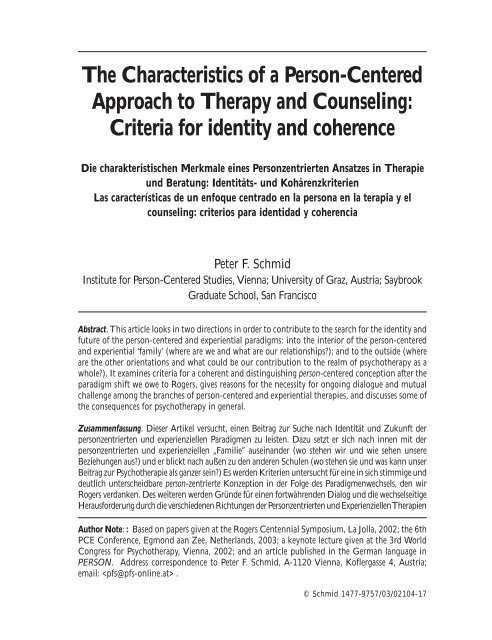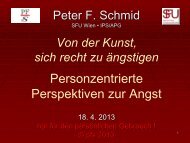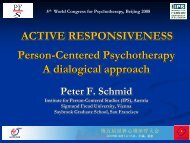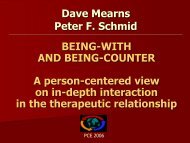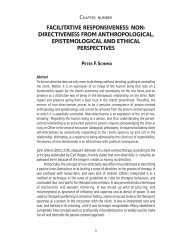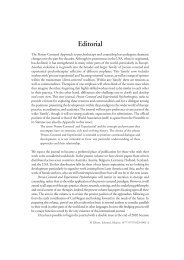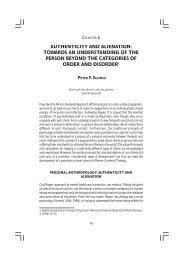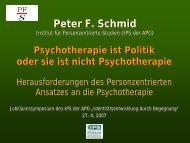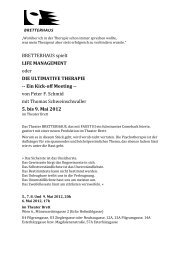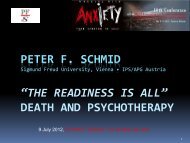The Characteristics of a Person-Centered ... - Peter F. Schmid
The Characteristics of a Person-Centered ... - Peter F. Schmid
The Characteristics of a Person-Centered ... - Peter F. Schmid
- No tags were found...
Create successful ePaper yourself
Turn your PDF publications into a flip-book with our unique Google optimized e-Paper software.
<strong>The</strong> <strong>Characteristics</strong> <strong>of</strong> a <strong>Person</strong>-<strong>Centered</strong> Approach<strong>The</strong> <strong>Characteristics</strong> <strong>of</strong> a <strong>Person</strong>-<strong>Centered</strong>Approach to <strong>The</strong>rapy and Counseling:Criteria for identity and coherenceDie charakteristischen Merkmale eines <strong>Person</strong>zentrierten Ansatzes in <strong>The</strong>rapieund Beratung: Identitäts- und KohärenzkriterienLas características de un enfoque centrado en la persona en la terapia y elcounseling: criterios para identidad y coherencia<strong>Peter</strong> F. <strong>Schmid</strong>Institute for <strong>Person</strong>-<strong>Centered</strong> Studies, Vienna; University <strong>of</strong> Graz, Austria; SaybrookGraduate School, San FranciscoAbstract. This article looks in two directions in order to contribute to the search for the identity andfuture <strong>of</strong> the person-centered and experiential paradigms: into the interior <strong>of</strong> the person-centeredand experiential ‘family’ (where are we and what are our relationships?); and to the outside (whereare the other orientations and what could be our contribution to the realm <strong>of</strong> psychotherapy as awhole?). It examines criteria for a coherent and distinguishing person-centered conception after theparadigm shift we owe to Rogers, gives reasons for the necessity for ongoing dialogue and mutualchallenge among the branches <strong>of</strong> person-centered and experiential therapies, and discusses some <strong>of</strong>the consequences for psychotherapy in general.Zusammenfassung. Dieser Artikel versucht, einen Beitrag zur Suche nach Identität und Zukunft derpersonzentrierten und experienziellen Paradigmen zu leisten. Dazu setzt er sich nach innen mit derpersonzentrierten und experienziellen „Familie” auseinander (wo stehen wir und wie sehen unsereBeziehungen aus?) und er blickt nach außen zu den anderen Schulen (wo stehen sie und was kann unserBeitrag zur Psychotherapie als ganzer sein?) Es werden Kriterien untersucht für eine in sich stimmige unddeutlich unterscheidbare person-zentrierte Konzeption in der Folge des Paradigmenwechsels, den wirRogers verdanken. Des weiteren werden Gründe für einen fortwährenden Dialog und die wechselseitigeHerausforderung durch die verschiedenen Richtungen der <strong>Person</strong>zentrierten und Experienziellen <strong>The</strong>rapienAuthor Note: : Based on papers given at the Rogers Centennial Symposium, La Jolla, 2002; the 6thPCE Conference, Egmond aan Zee, Netherlands, 2003; a keynote lecture given at the 3rd WorldCongress for Psychotherapy, Vienna, 2002; and an article published in the German language inPERSON. Address correspondence to <strong>Peter</strong> F. <strong>Schmid</strong>, A-1120 Vienna, K<strong>of</strong>lergasse 4, Austria;email: .104 <strong>Person</strong>-<strong>Centered</strong> and Experiential Psychotherapies, Volume © 2, <strong>Schmid</strong> Number 1477-9757/03/02104-172
<strong>The</strong> <strong>Characteristics</strong> <strong>of</strong> a <strong>Person</strong>-<strong>Centered</strong> Approachbetween therapist and client and the therapist’s authenticity as crucial for therapeutic success(for example: intersubjective psychoanalysis, systemic approaches, most humanistic modalitiesand even Cognitive Behavior <strong>The</strong>rapy). Nevertheless, these tendencies are still far behind theradical paradigm change <strong>of</strong> Rogers, because they all consider the therapeutic encounter as aprecondition for therapy but not as therapy itself.<strong>The</strong> controversies within the ‘family’Within the so-called ‘Rogerian family’ an increasing range <strong>of</strong> approaches and therapies havearisen. <strong>The</strong>re are developments with different accents. Orientations grow that are related toRogers’ ideas, but come to dissimilar conclusions from those <strong>of</strong> the founder. A variety <strong>of</strong>approaches claim to be person-centered or Rogerian, even if they call themselves, for example,Experiential <strong>The</strong>rapy, Focusing-Oriented <strong>The</strong>rapy, Focusing <strong>The</strong>rapy, Process-Directive<strong>The</strong>rapy, Goal-Oriented <strong>The</strong>rapy or understand themselves as eclectic, ‘integrative’ therapies.<strong>The</strong> discussion intensified and came to a head when some ‘classic’ authors even suspectedthat there were tendencies to simply make use <strong>of</strong> the PCA’s good name in order to ‘sell’ one’sown ideas. For example, on the one hand a fierce protest (Prouty, 2001; Bozarth, 2002;Brodley, 2002) arose involving controversy in the Journal <strong>of</strong> Humanistic Psychology (1999,issue 39 (4). On the other hand, the principles <strong>of</strong> the <strong>Person</strong>-<strong>Centered</strong> and ExperientialWorld Association and the European Network (www.pce-world.org, www.pce-europe.org)mark a strong position to both name and discuss the differences and foster cooperation.I agree with many <strong>of</strong> my colleagues (e.g., Spielh<strong>of</strong>er, 2001; Lietaer, 2002b; van Kalmthout,2002b) that it is crucial for our approaches to be identifiable and noticeable. Beyond this, Iam convinced that the argument will be the seed for further developments <strong>of</strong> the approachesand their positioning within the realm <strong>of</strong> psychotherapy (<strong>Schmid</strong>, 2002b; c; d; e; f).Among other notables this issue was raised by Lietaer (2002a; b), van Kalmthout (2002a),Swildens (2002), Sanders (2000). It was a topic at the General Assembly <strong>of</strong> the EuropeanNetwork 2002; the Salzburg Congress 2000 (Iseli et al., 2002); the 5th InternationalConference on Client-<strong>Centered</strong> and Experiential Psychotherapy in Chicago (Watson,Goldman and Warner, 2002); the International Colloquium, ‘Advancing person-centredtheory and practice: What is essential?’, 2001; and the 3rd PCA Colloquium, ‘What isessential? <strong>Person</strong>-centered and experiential psychotherapy – perspectives and prospects’, 2002(www.personzentriert.at/pca.htm) — to name only a few. <strong>The</strong> question for all these discussionsis about the ‘face’ <strong>of</strong> PCT.<strong>The</strong> necessity for criteriaWhy is it necessary to raise the question <strong>of</strong> identity criteria? <strong>The</strong> following are some <strong>of</strong> thereasons:• clarity about one’s own identity (regarding commonality and diversity): to be unambiguousin the foundation and development <strong>of</strong> one’s own identity, to know where we stand,what we have in common and what is diverse;• identifiability and transparency in communication: to have a ‘face’ and not to be faceless,to be able to be recognized and to be chosen (by clients and therapists);106 <strong>Person</strong>-<strong>Centered</strong> and Experiential Psychotherapies, Volume 2, Number 2
<strong>Schmid</strong>• trustworthiness for clients: to provide reliable conditions for the clients by <strong>of</strong>fering aconsistent, transparent and trustworthy relationship — perhaps the most importantcriterion;• intellectual coherence in theory: for the sake <strong>of</strong> congruence <strong>of</strong> anthropology, personalitytheory and theory <strong>of</strong> therapy;• reliability in dialogue and debate: to be a dependable partner for serious discussions withother orientations;• influence in the philosophy <strong>of</strong> health and in health and social politics: to promote one’sstance and make it attractive.For these reasons we need to have a face, which usually helps in recognizing a person. And aperson usually has one face.So what is our face? What makes the PCA the PCA? What makes it unique within therealm <strong>of</strong> psychotherapy, among all the modalities? What is the core <strong>of</strong> its identity? What isthe very essence <strong>of</strong> person-centeredness?To answer this question we need to identify criteria that can be used as guidelines todetermine what the <strong>Person</strong>-<strong>Centered</strong> Approach to therapy is all about.CRITERIOLOGY: HOW TO DETERMINE WHAT IS PERSON-CENTEREDAND WHAT IS NOTLietaer’s listing <strong>of</strong> criteriaA prominent voice in the controversy mentioned above is Germain Lietaer’s (2002a; b). Atseveral recent conferences he has differentiated between first- and second-order criteria: Firstorderaspects are elements that I see as specific for our paradigm; they belong to the deepestcore <strong>of</strong> our identity. Second-order aspects are explicitly emphasized in our therapy theory,yet they are also characteristic <strong>of</strong> some other paradigms or <strong>of</strong> some sub-approaches in them.Experience-centeredness falls under the first-order aspects, whereas person-centeredness comesunder the second-order aspects. This is because most other open exploratory forms <strong>of</strong>psychotherapy are equally not symptom-driven, but person-centered. As to the characteristics<strong>of</strong> the image <strong>of</strong> the human being, I also put them under the second-order aspects, againbecause they are not unique to our paradigm (Lietaer 2002a, pp. 12–13).From a person-centered view I respect Lietaer’s stance, but I contradict his premises. Mypoint regarding the order <strong>of</strong> aspects is different. Dialoguing about these differences mighthelp to further develop our respective paradigms.My view is the other way round: the first-order criterion <strong>of</strong> a person-centered approachis the image <strong>of</strong> the human being as a person. It focuses on the person and that takes in all theother aspects, including the focus on the experiential self (Lietaer’s first criterion). And ‘person’,correctly understood and in accordance with scientific research (cf. <strong>Schmid</strong> 1991; 1994;1998a; c), denotes a specific meaning <strong>of</strong> the human being which is different from that <strong>of</strong> all<strong>Person</strong>-<strong>Centered</strong> and Experiential Psychotherapies, Volume 2, Number 2 107
<strong>The</strong> <strong>Characteristics</strong> <strong>of</strong> a <strong>Person</strong>-<strong>Centered</strong> Approachother approaches, including the experiential therapies, in its essence and in the therapeuticconsequences. No other therapeutic paradigm has essentially the same view <strong>of</strong> the humanbeing which is truly characterized by the term ‘person’. Thus different conclusions on alllevels <strong>of</strong> theory and practice follow.This diverges clearly from Lietaer’s point <strong>of</strong> view, having the experiential self as thecommon denominator, which is why he conclusively sees experiential and person-centeredas the same. Different criteria rooted in different anthropological stances lead to differentviews, theories and practices.What is a criterion?<strong>The</strong> term ‘criterion’ denotes a touchstone, a distinguishing characteristic as a condition forgiven facts. <strong>The</strong> Greek word ‘κριτικος’ (from κρινειν: separate, sort out, distinguish;select; decide) means ‘separate’ and ‘select’. Thus a criterion is both a distinguishingcharacteristic and an existential decision (Meyer, 1997).<strong>The</strong>refore the question <strong>of</strong> criteria for person-centeredness is tw<strong>of</strong>old:1. What is the distinguishing character that describes a certain way <strong>of</strong> doing therapy asperson-centered?2. What is the foundation for the existential decision to do therapy in a certain way andnot in another way?If we ask any person-centered therapist what it means to be person-centered, they probablywould answer: ‘It’s not specific techniques or skills, but certain attitudes,’ and they probablywould name the ‘core conditions’ — which already in their common name point to the core— and their relation to the actualizing tendency and the therapeutic relationship. So thecriterion mentioned is something rooted in a certain image <strong>of</strong> the human being. And if wetake the meaning <strong>of</strong> criterion as the foundation for the decision to do therapy in a certainway and ask again, we probably would get an answer such as: ‘I chose to be person-centered,because I like how the client is treated and I would want to be treated in the same way if I wasin therapy.’ So the criteria are again the attitudes towards the client, now as an existentialdecision.<strong>The</strong>se answers would not only be the answers <strong>of</strong> the average practitioner, but theywould also derive from the state <strong>of</strong> the art <strong>of</strong> philosophy <strong>of</strong> science: a certain practice, itsrespective praxeology and theory, is always rooted in a specific image <strong>of</strong> the human being (cf.Hagehülsmann, 1984; Korunka, 2001).<strong>The</strong>refore the criterion defining whether doing therapy in a given way is person-centeredor not is not that someone claims to be person-centered, or has a certificate which licensesthem as a person-centered therapist; rather, the criteria are (1) the image <strong>of</strong> the human beingin which the therapy is rooted; and (2) the coherence (congruence) between (a) this image <strong>of</strong>the human being, (b) the theory <strong>of</strong> personality development, <strong>of</strong> relationship, <strong>of</strong> ‘disorders’and <strong>of</strong> therapy, and (c) the practice (i.e., the concrete behavior in therapy).108 <strong>Person</strong>-<strong>Centered</strong> and Experiential Psychotherapies, Volume 2, Number 2
<strong>Schmid</strong>What is an image <strong>of</strong> the human being?This so-<strong>of</strong>ten-cited image <strong>of</strong> the human being, mentioned above, is the personal answer tothe question, ‘What is a human being?’ In other, more scientific, terms an ‘image’ is a set <strong>of</strong>beliefs, including assumptions concerning how human beings are (what their nature is, theiressence, their peculiarity, their meaning <strong>of</strong> life, etc.), how they develop, how they get intotrouble and how they can be helped. Related questions are, for example, whether humansare free or not (and thus responsible or not), whether they are good or evil, etc.Images <strong>of</strong> the human being have the following characteristics:• they are models (representations <strong>of</strong> ideas <strong>of</strong> a typological nature);• they represent, select and construct ‘reality’ (i.e. they are not reality itself);• they have a heuristic function (they help to find new perspectives);• they serve as guidelines for practice;• and, most important, they are trans-empirical (they are basic beliefs — they cannot beproved).Thus it is no use arguing whether an image <strong>of</strong> the human being is right or wrong. What doesmake sense, however, is to investigate paradigms and theories regarding their consistencyand their accordance with empirical facts.<strong>The</strong>refore the image is the matrix, the foundation for science, theories and practice.For the PCA this leads to the seemingly simple conclusion: An approach is personcenteredif: (1) it regards the human being as a person, and (2) acts accordingly: that isperson to person.This makes it important to answer the question <strong>of</strong> what it actually means to be a person.What is a person-centered image <strong>of</strong> the human being?Now we are at the roots and, not coincidentally, at the name <strong>of</strong> the approach. If it is adequate,the name tells about the essence. <strong>The</strong> name <strong>of</strong> an idea is like the face <strong>of</strong> a human being. If youlook into someone’s face, you can see who this is. With the name, you can understand whatit is all about. (<strong>The</strong>refore, names need to be chosen carefully. And that is indeed what happenedwith the trademark ‘person-centered’; the same, by the way, for ‘experiential’ and most propernames <strong>of</strong> therapeutic schools.)What it means to be a person, and which consequences follow for a person-centeredapproach to psychotherapy, have been described in detail (<strong>Schmid</strong>, 1991; 1994; 1998c;2001a; 2002a, pp. 58–65; 2002c). Here we lack space for more than a short summary.According to two different, yet dialectically linked, traditional strands <strong>of</strong> meaning, thehuman being is characterized as a person if he or she is denoted in his or her uniqueindividuality, worth and dignity (the substantial notion <strong>of</strong> being a person), as well as his orher interconnectedness, being-from and being-towards others (relational conception <strong>of</strong>becoming a person). Thus to be a person describes both autonomy and solidarity, bothsovereignty and commitment. Carl Rogers combined both views in a unique way for<strong>Person</strong>-<strong>Centered</strong> and Experiential Psychotherapies, Volume 2, Number 2 109
<strong>The</strong> <strong>Characteristics</strong> <strong>of</strong> a <strong>Person</strong>-<strong>Centered</strong> Approachpsychotherapy when he built his theory and practice upon the actualizing tendency, whichworks at its best in facilitative relationships <strong>of</strong> a certain kind. <strong>Person</strong>-centered personalityand relationship theory understands personalization as a process <strong>of</strong> becoming independentand <strong>of</strong> developing relationships. <strong>The</strong> theory <strong>of</strong> the suffering person (‘theory <strong>of</strong> disorders’)relies on the incongruence between self and experience (which might be seen as sovereigntydeficiencies), as well as on the incongruence between the person and the context, includingthe other persons within the society (relationship deficiencies). Consequently, the theory <strong>of</strong>therapy understands therapy as both personality development and encounter person to person,and the practice is characterized by presence — which means a principled non-directivity andempathic positive regard as a way <strong>of</strong> being ‘with’ the client, together with a position ‘counter’the client, i.e. a committed ‘en-counter’ as a person meeting the Other face to face (<strong>Schmid</strong>2002a, pp. 60–2).CHARACTEROLOGY: THE DISTINGUISHING CHARACTERISTICS OF APERSON-CENTERED APPROACHIf this is the underlying image <strong>of</strong> the human being, then the distinguishing characteristics <strong>of</strong>a person-centered approach can be stated in the following three short sentences.(1) Client and therapist spring from a fundamental ‘We’.(2) <strong>The</strong> client comes first.(3) <strong>The</strong> therapist is present.Yet these seemingly simple statements imply a revolutionary change <strong>of</strong> paradigms.1. A fundamental ‘We’PCT starts with a fundamental We (<strong>Schmid</strong>, 2002e), which can be found already in Rogers’‘necessary and sufficient conditions’. In its basic statements the PCA is rooted in the convictionthat we are not merely a-contextual individuals, but we exist only as part <strong>of</strong> a ‘We’. Withoutstating it explicitly, this is inherent in Rogers’ theory from the very beginning. He starts thedescription <strong>of</strong> the first condition with the sentence: ‘I am hypothesizing that significantpositive personality change does not occur except in a relationship’ (Rogers, 1957, p. 96).<strong>The</strong> conditions start with ‘contact’ (1) and end with ‘communication’ (6).<strong>The</strong> Latin word communis means ‘to have common walls’ (‘munera’) — think <strong>of</strong> amedieval city as a community, a commune. We are all ‘in the same city’, ‘in the same boat’.None <strong>of</strong> us came to us from the outside; everyone was born within and into this We. If weignore this, we ignore that we are unavoidably a part <strong>of</strong> the world; we ignore our roots, ourpast, present and future. This would lead to the a-contextual view <strong>of</strong> the human being whichis so present in many so-called humanistic conceptions: a simplified here and now. <strong>The</strong>n weignore (in our image <strong>of</strong> the human as well as in the therapeutic practice) our limitedness, ourfiniteness; we ignore death. <strong>The</strong>n there never is a place for the partial lack <strong>of</strong> freedom we110 <strong>Person</strong>-<strong>Centered</strong> and Experiential Psychotherapies, Volume 2, Number 2
<strong>Schmid</strong>experience, for physical illness, transience, suffering and grief, etc., in our theory (cf. Swildens1988; 2002). In a word: we ignore the conditio humana.This has tremendous consequences concerning a theory <strong>of</strong> aggression, which is usuallya taboo in the person-centered context (<strong>Schmid</strong>, 1996, pp. 469–86). It has consequenceswithin the economical and ecological context <strong>of</strong> our global system <strong>of</strong> goods and resources. Ifwe ignore this We, we also ignore that there are others who are not only ‘with’; they are alsoagainst, ‘counter’, they are competitors; we have to share resources. And without ‘counter’there is no ‘en-counter’ (<strong>Schmid</strong>, 1994; 1998b; 2002a; e). Consequently, the whole approachwould become unrealistic and thus naïve.A personal therapy<strong>The</strong>re are four possible positions regarding the relationship between ‘I’ and ‘We’:• <strong>The</strong> individualistic position (I + I = [we]). It adds Egos and nevertheless never comes toa real We, because it sticks only to an aggregation <strong>of</strong> individuals.• <strong>The</strong> collectivistic position (we = [I] + [I]). It subordinates everybody to the collective, tothe totality.• <strong>The</strong> so-called humanistic position (we = I + you, where you = alter ego), as it can be widelyfound and had its high time in the period when the PCA was developed. It sees onlyalter egos; others are seen only from the point <strong>of</strong> view <strong>of</strong> the ego.• <strong>The</strong> personal or dialogic position (we = you + I, where you = an Other), as it is inherent inthe PCA (although not in every stage <strong>of</strong> its development). It overcame thefunctionalization <strong>of</strong> the other and regarded him/her as really an Other in the sense <strong>of</strong>dialogic philosophy, different from me, in whose view I am. This completely changedthe perspective. Now the I is seen from the point <strong>of</strong> view <strong>of</strong> the Other: Thou comesfirst. This is not only appropriate physically and from the perspective <strong>of</strong> developmentalpsychology (I am seen before I can see, I am conceived, awaited, accepted, lovedbefore I myself am able to see and love) — it is an epistemological revolution for theunderstanding <strong>of</strong> psychotherapy and the only way to really be aware <strong>of</strong> the ‘We’.From mere humanistic to personal — this marks the leap, the paradigmatic development inRogers’ work.A political perspectiveThis We includes our history and our culture. It is not an undifferentiated mass, nor is it anaccumulation <strong>of</strong> ‘Mes’; it includes commonality and difference, valuing both equally. Only acommon esteem for diversity constitutes and accepts a We.If we ignore this We, all the terrible and horrible things happen which we know fromthe history <strong>of</strong> humankind right up to the totalitarian regimes <strong>of</strong> the twentieth century, the11th <strong>of</strong> September 2001 and recent political developments towards a more or less totalitarianview <strong>of</strong> ‘missions’ which allegedly have to be fulfilled. Those developments did not comefrom ‘primitive’ or minor developed cultures; it was our cultures in which the horror originated.Enlightenment and humanism have been unable to prevent the terror regimes <strong>of</strong> the twentieth<strong>Person</strong>-<strong>Centered</strong> and Experiential Psychotherapies, Volume 2, Number 2 111
<strong>Schmid</strong><strong>The</strong> therapist tries to ‘perceive and understand’. This denotes a Thou–I relationship as opposedto the ‘egology’ — what Levinas (1957, p. 189), using Husserl’s neologism, called the traditionaloccidental understanding — <strong>of</strong> the conventional humanistic approaches. <strong>The</strong>refore, thePCA goes far beyond these ‘humanistic’ approaches.For the understanding <strong>of</strong> ‘person’, it follows that being a person means: to disclose, to revealoneself to oneself and to the Other, thus enabling ‘co-experiencing’. This is the special notion <strong>of</strong>‘person’ inherent to the PCA, which is far different from what a lot <strong>of</strong> people, includingtherapists <strong>of</strong> all kind <strong>of</strong> orientations, mean when they say ‘I see you as a person.’ It alsodefinitely goes beyond what is considered to be the common ground <strong>of</strong> all humanisticapproaches in psychology: namely, that the human being comes into the view as a human(hence the name) and not only according to the criteria <strong>of</strong> natural science — a developmentundoubtedly important to overcome an objectifying understanding <strong>of</strong> therapy. Many stillrefer to this if they regard the human being as a person, also within the ‘Rogerian family’ (seeLietaer, 2002a). But the notion <strong>of</strong> being a person, as it is the underlying ground <strong>of</strong> the PCA,is much more specific and radical: <strong>The</strong> epistemological paradigm change just mentionedimplies that the expert in the therapeutic endeavor, in any respect, is the client.‘<strong>The</strong> client comes first’ can also now be expressed by: ‘<strong>The</strong> client is the expert.’<strong>The</strong> client is the expert<strong>The</strong>re are three possible positions on expertism in psychotherapy:(1) <strong>The</strong> therapist is the expert for the contents and the process (which means what thetherapy considers, the methods, the means, the procedure, the skills).This is a principleheld, for example in CBT.(2) <strong>The</strong> client is the expert for the contents and the therapist is (at least partially) theprocess expert, the expert for the way therapy goes. This can be found in gestalt andexperiential therapies.(3) <strong>The</strong> third possibility is that the client is the expert for both — problems and methods— and the therapist is a facilitator: a stance to be found only in genuine PCT.To sum up:• In PCT the client comes first– phenomenologically (Thou–I relationship);– in terms <strong>of</strong> the contents (the client is the one who ‘knows’ what it is allabout); and– in terms <strong>of</strong> the process (i.e., the way <strong>of</strong> communication, the ‘languages’, themeans <strong>of</strong> therapy).• <strong>The</strong> therapist is responding existentially, i.e., as a person. By encountering each other theyacknowledge the ‘We’ mentioned above.3. <strong>The</strong> therapist is presentIn a personal context, to respond existentially means to be present and available as a person<strong>Person</strong>-<strong>Centered</strong> and Experiential Psychotherapies, Volume 2, Number 2 113
<strong>The</strong> <strong>Characteristics</strong> <strong>of</strong> a <strong>Person</strong>-<strong>Centered</strong> Approachto the client. It could also be formulated, as Rogers (1975) did, that the therapist encountersthe client person to person.Presence is the fundamental way <strong>of</strong> ‘being together’, the existential foundation <strong>of</strong> thecore conditions (<strong>Schmid</strong>, 1994; 2002d; f, pp. 62–5; 2003; Brodley 2000; Geller andGreenberg, 2002). It is possible only from a We-perspective. Presence is:• co-operation arising out <strong>of</strong> co-existence;• co-responding (to given experiencings) out <strong>of</strong> co-experiencing;• co-creating out <strong>of</strong> (in its best moments mutual) encounter.Dimensions <strong>of</strong> presenceSome <strong>of</strong> the basic dimensions <strong>of</strong> ‘presence’ are as follows (cf. <strong>Schmid</strong>, 2002g, pp. 190–201):• its principled non-directivity: Non-directivity is not at all outdated in the understanding<strong>of</strong> PCT. It is a way <strong>of</strong> facilitative responsiveness which exactly meets the needs <strong>of</strong> aphenomenological approach;• its kairoticity: In old Greece Kairos was the god <strong>of</strong> the fertile instant, <strong>of</strong> the favorableopportunity, and hence ‘καιρος’ is the Greek word for the quality <strong>of</strong> time. Kairology,then, is the science <strong>of</strong> the right action at the right time (as, for example, undertaken byKierkegaard, 1855; cf. <strong>Schmid</strong>, 2002g, pp. 183–4). This points out that the fertilemoment is always now. <strong>The</strong> moment for the change is now and here. <strong>The</strong> moment toinfluence the future is now and here. <strong>The</strong> moment to pr<strong>of</strong>it from the past is now andhere. <strong>The</strong>re is only one time: the present. Future is the present anticipation <strong>of</strong> what iscoming, past is the remembrance — in the present — <strong>of</strong> what happened. We live inonly one time: the present. We exist here and we exist now. And thus we are called toact in the present and to grasp the chance. In therapy the question always is: Whatpresents itself in the very moment?• its ‘en-counter’ character: <strong>The</strong> word ‘counter’ (see above) stresses the otherness <strong>of</strong> theOther and opens up the room for both acknowledgment and counter-position;• its ‘im-media-cy’: Presence happens without (preconceived) media or tools, because theonly ‘tool’ is the therapist himself or herself as a person, his or her own ‘instrument’.Methods are <strong>of</strong> second importance, even irrelevant; PCT never acts ‘in order to’ achievea certain goal;• its movement from perception to realization: ‘Realization’ means encompassing not onlywhat is, but also what can be; not only facticity but also possibility, chances, prospects,oncoming resources. Thus ‘realization’ goes far beyond just experiencing. <strong>The</strong>refore Iam convinced that, since the main focus <strong>of</strong> PCT is on the person and not on theexperiencing self (see above), a person-centered and an experiential therapy are twodifferent enterprises with two different underlying anthropological and epistemologicalviews. We owe Gendlin important insights to clearing and deepening the understanding<strong>of</strong> the process in the client; this marks a real progress in person-centered understanding.But from the point <strong>of</strong> view <strong>of</strong> a person-centered therapy, the focus on the experiencingself is a reductionistic position, a reduction <strong>of</strong> the person to the experiencing self. Aperson is not identical with its experiencing; from the philosophy outlined above it is114 <strong>Person</strong>-<strong>Centered</strong> and Experiential Psychotherapies, Volume 2, Number 2
<strong>Schmid</strong>more than its experiencing self (cf. Prouty, 2001);• its correspondence with personalization: Presence ‘co-responds’ with becoming a person.To be present means to answer to the other person, to be the response to a call as aperson. <strong>The</strong> person him- or herself is the response. This is the deepest core <strong>of</strong> whatbeing and becoming a person means; this is in line with the personalistic (dialogic,encounter philosophical) understanding <strong>of</strong> person and the notion <strong>of</strong> person in thePCA. Among the schools <strong>of</strong> therapy this notion can be found only in PCT.<strong>The</strong> necessary and sufficient conditions as an ethical statementThis also means that the necessary and sufficient conditions <strong>of</strong> 1957 — althoughconceptualized as a metatheory, so far realized theoretically only in PCT — are not onlyhypotheses for empirical research, but a philosophical statement (in terms <strong>of</strong> anthropologyand epistemology) and — strictly speaking — an ethical statement. This sheds more light onthe understanding <strong>of</strong> person and <strong>of</strong> therapy: as explained elsewhere (<strong>Schmid</strong>, 2002a, p.66; c;d), to encounter person to person constitutes an ethical position. To do therapy means beingaddressed by an Other to respond out <strong>of</strong> one’s response-ability. <strong>The</strong> challenge is not onlywhether, but how to respond. Thus PCT is the pr<strong>of</strong>essional personal response to this call by aperson in need (a call which itself is seen as a personal address, i.e., the call <strong>of</strong> a person, andnot a disease, a problem or a disorder; <strong>Schmid</strong>, 2001a; 2002c; d).<strong>The</strong> characterizing fundamental statements explaining a genuinely person-centeredapproach can be reformulated:1. Client and therapist co-operate on the basis <strong>of</strong> a fundamental ‘We,’ whichconstitutes their relationship person to person.2. <strong>The</strong> client comes first, because he or she is the expert.3. <strong>The</strong> therapist responds to the client’s call by being present.It can be shown that the fundamental ‘co-’, the ‘priority’ <strong>of</strong> the client and the meaning <strong>of</strong>presence is both inherent in Rogers’s thinking and acting (the later the more so), althoughnot explicated in detail (for example, the relational, intersubjective and ethical approach <strong>of</strong>the necessary and sufficient conditions, the principled non-directivity and client-centeredness,therapy as encounter and presence as immediacy <strong>of</strong> the relationship, etc.) and it is a genuinefurther elaboration and development from the approach, that is, consistent with the philosophyand the basic premises and principles <strong>of</strong> person-centeredness (for details and references see<strong>Schmid</strong>, 1991, pp. 117–61; 1994, pp. 111–294; 1996, pp. 511–40; 2002d; also: 2001b; c;d; 2002c; g; 2003).FUTUROLOGY: THE IMAGE OF THE HUMAN BEING AS THE DECISIVECRITERION AND CHALLENGE<strong>The</strong> conclusion <strong>of</strong> these considerations is that the crucial point <strong>of</strong> PCT is its image <strong>of</strong> thehuman being, which is unique among the schools <strong>of</strong> psychotherapy. It is decisive, because it<strong>Person</strong>-<strong>Centered</strong> and Experiential Psychotherapies, Volume 2, Number 2 115
<strong>The</strong> <strong>Characteristics</strong> <strong>of</strong> a <strong>Person</strong>-<strong>Centered</strong> Approachdecides whether an approach is person-centered or not: whether it regards the human beingas a person and understands the therapeutic relationship as an encounter person to person.This includes the substantial view: the ‘expert’s’ actualizing tendency is taken seriously; andnothing has to be ‘added’ or imposed. And it includes the relational dimension: client andtherapist are co-experiencing, co-operating and co-creating on the basis <strong>of</strong> their fundamentalWe; they are not split into the therapist with his or her expertise and the client with his or herneed to be treated. It is crucial to keep the balance between the two dimensions.<strong>The</strong> impact <strong>of</strong> the image <strong>of</strong> the human being on different levels <strong>of</strong> the therapeuticenterpriseIn other words, the crucial point for PCT, its unique ‘face’ is to be convinced that the Rogerianconditions are not only necessary, but sufficient. <strong>The</strong> necessary conditions regard the humanbeing as a person, if they are seen as sufficient. (A fundamental position, not at all afundamentalistic one: to the contrary, it is a revolutionary stance, oriented towards continuousdevelopment.)This can be spelled out on all levels <strong>of</strong> theory and practice:• in anthropological language it means that the focus is on a person, instead <strong>of</strong> a patient orclient;• in dialogic language it is a Thou–I relationship out <strong>of</strong> a We instead <strong>of</strong> an I–Thourelationship;• in phenomenological language the task <strong>of</strong> both the therapist and the client is to be opento what is revealed instead <strong>of</strong> diagnostic observing;• in epistemological language this means primarily experiencing acknowledgment instead<strong>of</strong> gaining knowledge;• in the language <strong>of</strong> a theory <strong>of</strong> ‘disorders’ it is about resources instead <strong>of</strong> problems, theability for growth instead <strong>of</strong> the removal <strong>of</strong> disorders;• in the language <strong>of</strong> a theory <strong>of</strong> relationship the challenge is to encounter instead <strong>of</strong> ‘making’or ‘building’ a relationship;• in existential language: the therapist is open to being touched and is present instead <strong>of</strong>seeking purposefully or finding out. (An encounter relationship must never be a means‘in order to’ — this instrumentalizes the relationship and the persons involved. To‘use’ the relationship does not meet the person-centered image <strong>of</strong> the human being);• in technical language it is about listening and being facilitative instead <strong>of</strong> guiding, steeringor giving process advice;• in ethical language therapy means responding to a call instead <strong>of</strong> advising and moralizing;• in pedagogical and didactical language becoming a therapist means to be ‘e-ducated’ (inGerman: ‘[Her-]Aus-Bildung’) instead <strong>of</strong> being trained. Often the objection is raisedthat this would be too much for the trainees — a personal attitude as such cannot belearned and therefore a training <strong>of</strong> special skills (with the meaning <strong>of</strong> specific tools) isneeded. My experience is different: just as it is necessary in therapy, instead <strong>of</strong> fulfillingthe client’s wishes for easy solutions, not to give in and challenge them, the same goesfor ‘training’ — to challenge the ‘trainees’ in a facilitative way to find their own ways116 <strong>Person</strong>-<strong>Centered</strong> and Experiential Psychotherapies, Volume 2, Number 2
<strong>Schmid</strong><strong>of</strong> relating and communicating).<strong>Person</strong>-centered futurologyOne hundred years after the birth <strong>of</strong> its founder: what will be the challenges for PCT in thenext ‘hundred years’? I envision that what will be at stake is not PCT as such, or the disputeamong the orientations or the interests <strong>of</strong> the therapeutic pr<strong>of</strong>ession. At stake will be whatpsychotherapy can contribute to the development <strong>of</strong> humankind and society, that is, a way<strong>of</strong> living together.<strong>The</strong> elaborated criterion also <strong>of</strong>fers a futurologic contribution. This refers to the branch<strong>of</strong> futurology which regards itself as the philosophy <strong>of</strong> the future, in so far as one <strong>of</strong> itsforemost tasks is to pursue critics <strong>of</strong> ideologies and utopias in order to point out alternativepossibilities <strong>of</strong> development and other foundations for decisions.Towards the end <strong>of</strong> his life Rogers did not turn coincidentally to conflict research andpeace work. <strong>The</strong> image <strong>of</strong> the human being, its critical reflection and the research stimulated,together with the respective practice, will not only decide about the standing <strong>of</strong> psychotherapywithin the society <strong>of</strong> tomorrow, and thus its impact on individual ‘health’, but they will als<strong>of</strong>oster or hinder our way <strong>of</strong> dealing with each other, in one-to-one relationships, in andbetween groups, communities, cultures and on a global level. It still remains an open questionwhether we will succeed in corresponding with the fundamental ‘We’ and trusting eachother as persons in a globalized world, with its fear <strong>of</strong> the Other as a stranger, its enforcedpolitical conformity and its monopolization. Psychotherapy could contribute to theemancipation <strong>of</strong> humankind by the opening up <strong>of</strong> possibilities for decisions, and throughthe opening up <strong>of</strong> possibilities for the understanding <strong>of</strong> both the individual and society.<strong>The</strong>se political implications once more show the ongoing challenges <strong>of</strong> the personcenteredparadigm change, initiated by Carl Rogers: to the other orientations <strong>of</strong> psychotherapyit means to do justice to the human by really viewing him or her as a human being, and thusto keep the promise <strong>of</strong> the founding ideal <strong>of</strong> all emancipatory schools <strong>of</strong> therapy. <strong>The</strong> ongoingchallenge to person-centered therapists is to be congruent with their philosophy and t<strong>of</strong>urther explicate foundations, philosophy, theory and practice — in dialogue with othermodalities and through dialogue and co-operation within the ‘family’.It is the acknowledgment <strong>of</strong> the human being as a person that remains the central valueand challenge for psychotherapy; as Carl Rogers (1989, p. 106) stated towards the end <strong>of</strong> hislife, ‘I’m willing to stand by valuing the person above anything else.’REFERENCESBozarth, J. (2002). Untitled paper, distributed at the Rogers Centennial Symposium, La Jolla, CA.Brodley, B. T. (2000). <strong>Person</strong>al presence in client-centered therapy. <strong>Person</strong>-<strong>Centered</strong> Journal, 7(2),139–49.Brodley, B. T. (2002). Invited presentation. Rogers Centennial Symposium, La Jolla, CA.<strong>Person</strong>-<strong>Centered</strong> and Experiential Psychotherapies, Volume 2, Number 2 117
<strong>The</strong> <strong>Characteristics</strong> <strong>of</strong> a <strong>Person</strong>-<strong>Centered</strong> ApproachGeller, S. M. and Greenberg, L. S. (2002). <strong>The</strong>rapeutic presence: <strong>The</strong>rapist’s experience <strong>of</strong> presencein the psychotherapeutic encounter. <strong>Person</strong>-<strong>Centered</strong> and Experiential Psychotherapies, 1(1/2),71–86.Hagehülsmann, H. (1984). Begriff und Funktion von Menschenbildern in Psychologie undPsychotherapie. In H. Petzold (Ed.) Wege zum Menschen, Vol. I. Paderborn, Germany:Junfermann, pp. 9–44.Kierkegaard, S. (1855). Øieblikket. Copenhagen.Korunka, C. (2001). Die philosophischen Grundlagen und das Menschenbild des <strong>Person</strong>zentriertenAnsatzes. In P. Frenzel, W. W. Keil, P. F. <strong>Schmid</strong> and N. Stölzl (Eds). Klienten-/<strong>Person</strong>zentriertePsychotherapie: Kontexte, Konzepte, Konkretisierungen. Vienna: Facultas, pp. 33–56.Iseli, C., Keil, W. W., Korbei, L., Nemeskeri, N., Rasch-Owald, S., <strong>Schmid</strong>, P. F. and Wacker, P.(Eds). (2002). Identität – Begegnung – Kooperation: <strong>Person</strong>-/Klientenzentrierte Psychotherapieund Beratung an der Jahrhundertwende. Köln, Germany: GwG.Levinas, E. (1957). Die Spur des Anderen. Freiburg i. Br, Germany: Alber, 1983, pp. 185–208.Lietaer, G. (2002a). <strong>The</strong> client-centered/experiential paradigm in psychotherapy: Development andidentity. In J. C. Watson, R. N. Goldman and M. S. Warner (Eds). Client-centered andExperiential Psychotherapy in the 21st Century. Ross-on-Wye, UK: PCCS Books, pp. 1–15.Lietaer, G. (2002b). <strong>The</strong> united colours <strong>of</strong> PCEP. <strong>Person</strong>-<strong>Centered</strong> and Experiential Psychotherapies,1(1/2), 4–13.Meyer (1997). Lexikon in drei Bänden. Mannheim, Germany: Bibliographisches Institut; CD-ROM: LexiROM, 4th edn. (1999).O’Hara, M. (1998). <strong>Person</strong>zentrierte und experientielle Psychotherapie in einem kulturellenÜbergangszeitalter. PERSON, 2(1), 5–14.Prouty, G. (2001). Carl Rogers and experiential therapies: A dissonance? <strong>Person</strong>-Centred Practice,7(1), 4–12.Richter, H.-E. (2002). <strong>The</strong> end <strong>of</strong> egomania. Paper, 3rd World Congress for Psychotherapy.Rogers, C. R. (1957). <strong>The</strong> necessary and sufficient conditions <strong>of</strong> therapeutic personality change.Journal <strong>of</strong> Consulting Psychology, 21(2), 95–103.Rogers, C. R. (1975), Client-centered psychotherapy. In A. M. Freedman, H. I. Kaplan and B. J.Sadock (Eds). Comprehensive Textbook <strong>of</strong> Psychiatry, II, Vol. 2. Baltimore, MD: Williams andWilkins, 2nd edn, pp. 1831–43.Rogers, C. R. (1989). An interview with Carl Rogers, by David Ryback. <strong>Person</strong>-<strong>Centered</strong> Review,4(1), 99–112.Sanders, P. (2000). Definitions <strong>of</strong> principles and practice acceptable to person-centred practitioners.Paper, 5th ICCCEP, Chicago.<strong>Schmid</strong>, P. F. (1991). Souveränität und Engagement: Zu einem personzentrierten Verständnis von‘<strong>Person</strong>’. In Rogers, C. R. and <strong>Schmid</strong>, P. F., <strong>Person</strong>-zentriert: Grundlagen von <strong>The</strong>orie undPraxis. Mainz, Germany: Grünewald, 4th edn (2000), pp. 15–164.<strong>Schmid</strong>, P. F. (1994). <strong>Person</strong>zentrierte Gruppenpsychotherapie: Ein Handbuch, Vol. I: Solidarität undAutonomie. Köln, Germany: EHP.<strong>Schmid</strong>, P. F. (1996). <strong>Person</strong>zentrierte Gruppenpsychotherapie in der Praxis: Ein Handbuch, Vol. II: DieKunst der Begegnung. Paderborn, Germany: Junfermann.<strong>Schmid</strong>, P. F. (1998a). ‘On becoming a person-centered approach’: A person-centred understanding<strong>of</strong> the person. In B. Thorne and E. Lambers (Eds). <strong>Person</strong>-centred <strong>The</strong>rapy: A European perspective.London: Sage, pp. 38–52.118 <strong>Person</strong>-<strong>Centered</strong> and Experiential Psychotherapies, Volume 2, Number 2
<strong>Schmid</strong><strong>Schmid</strong>, P. F. (1998b). ‘Face to face’: <strong>The</strong> art <strong>of</strong> encounter. In B. Thorne and E. Lambers (Eds).<strong>Person</strong>-centred <strong>The</strong>rapy. London: Sage, pp. 74–90.<strong>Schmid</strong>, P. F. (1998c). Im Anfang ist Gemeinschaft: <strong>Person</strong>zentrierte Gruppenarbeit in Seelsorge undPraktischer <strong>The</strong>ologie. Stuttgart, Germany: Kohlhammer.<strong>Schmid</strong>, P. F. (2001a). <strong>Person</strong>zentrierte Persönlichkeits- und Beziehungstheorie, in: P. Frenzel, W.W. Keil, P. F. <strong>Schmid</strong> and N. Stölzl (Eds). Klienten-/<strong>Person</strong>zentrierte Psychotherapie. Vienna:Facultas, pp. 57–95.<strong>Schmid</strong>, P. F. (2001b). Authenticity: the person as his or her own author: Dialogical and ethicalperspectives on therapy as an encounter relationship. And Beyond. In G. Wyatt, (Ed.) Congruence.Ross-on-Wye, UK: PCCS Books, pp. 213–28.<strong>Schmid</strong>, P. F. (2001c). Comprehension: <strong>The</strong> art <strong>of</strong> not-knowing. Dialogical and ethical perspectiveson empathy as dialogue in personal and person-centred relationships. In S. Haugh and T.Merry (Eds). Empathy. Ross-on-Wye, UK: PCCS Books, pp. 53–71.<strong>Schmid</strong>, P. F. (2001d). Acknowledgement: <strong>The</strong> art <strong>of</strong> responding. Dialogical and ethical perspectiveson the challenge <strong>of</strong> unconditional personal relationships in therapy and beyond. In J. Bozarthand P. Wilkins (Eds). Unconditional Positive Regard. Ross-on-Wye, UK: PCCS Books, pp. 49–64.<strong>Schmid</strong>, P. F. (2002a). Knowledge or acknowledgement? Psychotherapy as ‘the art <strong>of</strong> not-knowing’— Prospects on further developments <strong>of</strong> a radical paradigm. <strong>Person</strong>-<strong>Centered</strong> and ExperientialPsychotherapies, 1(1/2), 56–70.<strong>Schmid</strong>, P. F. (2002b). Was ist personzentriert? Zur Frage von Identität, Integrität, Integration undAbgrenzung. In C. Iseli, W. W. Keil, L. Korbei, N. Nemeskeri, S. Rasch-Owald, P. F. <strong>Schmid</strong>and P. Wacker (Eds). Identität – Begegnung – Kooperation. Köln, Germany: GwG, pp. 219–54.<strong>Schmid</strong>, P. F. (2002c). ‘<strong>The</strong> necessary and sufficient conditions <strong>of</strong> being person-centered’: On identity,integrity, integration and differentiation <strong>of</strong> the paradigm. In J. C. Watson, R. Goldman andM. S. Warner (Eds). Client-centered and Experiential Psychotherapy in the 21st Century. Ross-on-Wye, UK: PCCS Books, pp. 36–51.<strong>Schmid</strong>, P. F. (2002d). Anspruch und Antwort: <strong>Person</strong>zentrierte Psychotherapie als Begegnung von<strong>Person</strong> zu <strong>Person</strong>, In W. W. Keil and G. Stumm (Eds). Die vielen Gesichter der <strong>Person</strong>zentriertenPsychotherapie. Vienna: Springer, pp. 75–105.<strong>Schmid</strong>, P. F. (2002e).<strong>The</strong> unavoidable We in therapy. Invited presentation, Rogers CentennialSymposium, La Jolla, CA.<strong>Schmid</strong>, P.F. (2002f). Die <strong>Person</strong> im Zentrum der <strong>The</strong>rapie: Zu den Identitätskriterien<strong>Person</strong>zentrierter <strong>The</strong>rapie und zur bleibenden Herausforderung von Carl Rogers an diePsychotherapie. PERSON, 6(1), 16–33.<strong>Schmid</strong>, P. F. (2002g). Presence: Im-media-te co-experiencing and co-responding. Phenomenological,dialogical and ethical perspectives on contact and perception in person-centred therapy andbeyond. In G. Wyatt and P. Sanders (Eds). Contact and Perception. Ross-on-Wye, UK: PCCSBooks, pp. 182–203.<strong>Schmid</strong>, P. F. (2002h). <strong>The</strong> person in the center <strong>of</strong> therapy: <strong>The</strong> ongoing challenge <strong>of</strong> Carl Rogersfor psychotherapy. Keynote lecture, 3rd World Congress for Psychotherapy. Vienna.<strong>Schmid</strong>, P. F. (2003). Presence — co-creating the therapeutic relationship out <strong>of</strong> the fertile moment:A kairologic approach to therapy. Presentation, 6th PCE Conference, Egmond aan Zee,Netherlands.Spielh<strong>of</strong>er, H. (2001). Organismisches Erleben und Selbst-Erfahrung: Ein Beitrag zur Diskussion<strong>Person</strong>-<strong>Centered</strong> and Experiential Psychotherapies, Volume 2, Number 2 119
<strong>The</strong> <strong>Characteristics</strong> <strong>of</strong> a <strong>Person</strong>-<strong>Centered</strong> Approachder anthropologischen und persönlichkeitstheoretischen Grundlagen im personzentriertenAnsatz. PERSON, 5(1), 5–18.Swildens, H. (1988). De cliëntgerichte gesprekstherapie in existentieel perspectief. In D. Debats(Ed.) Psychotherapie en zingeving. Leuven, Belgium: Acco.Swildens, H. (2002). Where did we come from and where are we going? <strong>The</strong> development <strong>of</strong>person-centered psychotherapy. <strong>Person</strong>-<strong>Centered</strong> and Experiential Psychotherapies, 1(1/2), 118–31.van Kalmthout, M. (2002a). <strong>The</strong> farther reaches <strong>of</strong> person-centered psychotherapy. In J. C. Watson,R. Goldman and M. S. Warner (Eds). Client-centered and Experiential Psychotherapy in the 21stCentury. Ross-on-Wye, UK: PCCS Books, pp. 127–43.van Kalmthout, M. (2002b). <strong>The</strong> future <strong>of</strong> PCT: Crisis and possibility. <strong>Person</strong>-<strong>Centered</strong> andExperiential Psychotherapies, 1(1/2), 132–43.Watson, J. C., Goldman, R. N. and Warner, M. S. (Eds). (2002). Client-centered and ExperientialPsychotherapy in the 21st Century. Ross-on-Wye, UK: PCCS Books.120 <strong>Person</strong>-<strong>Centered</strong> and Experiential Psychotherapies, Volume 2, Number 2


